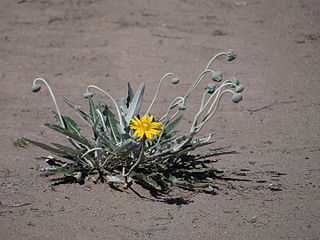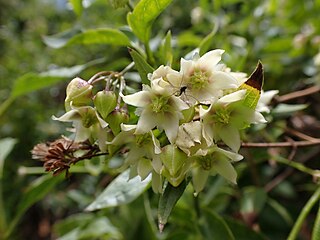
The Asclepiadoideae are a subfamily of plants in the family Apocynaceae. Formerly, they were treated as a separate family under the name Asclepiadaceae, e.g. by APG II, and known as the milkweed family.

Nothoscordum is a genus of New World plants in the onion tribe within the Amaryllis family. It is probably paraphyletic. The genus is native to North, Central and South America, though a few species have become naturalized in various parts of the Old World.

Schinus is a genus of flowering trees and tall shrubs in the sumac family, Anacardiaceae. Members of the genus are commonly known as pepper trees. The Peruvian pepper tree is the source of the spice known as pink peppercorn.

Mandevilla is a genus of tropical and subtropical flowering vines belonging to the family Apocynaceae. It was first described as a genus in 1840. A common name is rocktrumpet.

Trixis is a genus of shrubs in the family Asteraceae, native to North and South America including the West Indies.

Araujia odorata, formerly known as Morrenia odorata, the latexplant or strangler vine, is a plant in the family Apocynaceae, which is native to South America. This plant is cited in Flora Brasiliensis by Carl Friedrich Philipp von Martius. The species is widely cultivated as an ornamental.

Oxypetalum is a genus of flowering plants in the family Apocynaceae, first described with this name in 1810. The genus is native to South America.

Forsteronia is a genus of plants in the family Apocynaceae, first described as a genus in 1818. It is native to South America, Central America, Mexico, and the West Indies.

Araujia is a small genus of perennial vines in the dogbane family first described as a genus in 1817. The group is native to South America.
- Araujia angustifolia(Hook. & Arn.) Steud. - Brazil, Paraguay, Uruguay, NE Argentina
- Araujia graveolens(Lindl.) Mast. - Brazil
- Araujia herzogii(Schltr.) Fontella & Goyder - Bolivia
- Araujia hortorumE.Fourn. - Brazil, Paraguay, Uruguay, NE Argentina
- Araujia megapotamica(Spreng.) G.Don - Brazil, Uruguay, NE Argentina
- Araujia plumosaSchltr. - Brazil, Paraguay, Bolivia, NW Argentina
- Araujia sericiferaBrot. - white bladderflower, cruel vine - Peru, Brazil; naturalized in parts of South Africa + United States
- Araujia stuckertiana(Kurtz ex Heger) Fontella & Goyder - Cordoba in Argentina
- Araujia subhastataE.Fourn. - Brazil

Austroeupatorium is a genus of plants native primarily to South America, including herbaceous perennials and shrubs. The native range is focused on eastern South America and extends as far north as Panama and Trinidad and as far west as Bolivia.

Trichocline is a genus of Australian and South American plants in the tribe Mutisieae within the family Asteraceae. It consists of one species from Australia (T. spathulata) and twenty-three from South America.

Sarcoglottis is a genus of flowering plants from the orchid family, Orchidaceae. It is widespread across much of Latin America from Mexico to Argentina, with one species extending northward into Trinidad and the Windward Islands.
Sauroglossum is a genus of flowering plants from the orchid family, Orchidaceae. The genus is endemic to South America. As of June 2014, the following species are recognized:
- Sauroglossum andinum(Hauman) Garay - Ecuador, Argentina
- Sauroglossum aurantiacum(C.Schweinf.) Garay - Peru
- Sauroglossum corymbosum(Lindl.) Garay - Peru, Bolivia
- Sauroglossum distansLindl. ex Garay - Bolivia
- Sauroglossum dromadumSzlach. - Peru
- Sauroglossum elatumLindl - Ecuador, Argentina, Colombia, Brazil
- Sauroglossum longiflorum(Schltr.) Garay - Ecuador, Colombia
- Sauroglossum odoratumRobatsch - Rio de Janeiro
- Sauroglossum organenseSzlach. - Rio de Janeiro
- Sauroglossum schweinfurthianumGaray - Peru
- Sauroglossum sellilabre(Griseb.) Schltr. - Paraguay, Argentina

Herreria is a genus of flowering plants native to South America. In the APG III classification system, the genus is placed in the family Asparagaceae, subfamily Agavoideae.
Tweedia is a genus of flowering plants in the family Apocynaceae, first described as a genus in 1835. The genus is native to South America. An ornamental plant, Oxypetalum coeruleum, formerly included in this genus is commonly referred to as "tweedia".
- Tweedia andina(Phil.) G.H.Rua - Chile
- Tweedia aucaensisG.H. Rua - Argentina
- Tweedia australis(Malme) C. Ezcurra - Argentina
- Tweedia birostrata(Hook. & Arn.) Hook. & Arn. - Chile
- Tweedia brunonisHook. & Arn. - Argentina, Bolivia, Paraguay
- Tweedia echegarayi(Hieron.) Malme - Argentina
- Tweedia solanoides(Hook. & Arn.) Chittenden - Argentina, Brazil, Paraguay, Uruguay

Philibertia is a genus of flowering plants in the family Apocynaceae, first described as a genus in 1819. It is native to South America.

Jobinia is a genus of flowering plants of the family Apocynaceae first described in 1885. It is native to South America and Central America.

Ruehssia is a genus of plants in the family Apocynaceae. It is also in the Asclepiadoideae subfamily and Marsdenieae tribe.
Cristobalia is a genus of flowering plants in the dogbane family (Apocynaceae). It includes four species which are native to Bolivia, Paraguay, southern Brazil, Uruguay, and northern Argentina in South America.
















